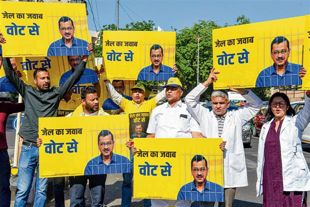
Number talk: We must brace ourselves for sub-7 per cent growth. Not very good news in the midst of all the chest-thumping we have seen.
Mythili Bhusnurmath
An Economic Survey is essentially an economic scorecard of the government in power. To the extent it is an insider’s view (the Survey is the handiwork of the Chief Economic Adviser) it is usually a charitable view. At the same time, since it reflects a technocrat’s view, it is also an apolitical view of the economy and the challenges ahead.
Whatever the yardstick, there’s no denying that the Economic Survey Mark II – a mid-year update of the Survey released before the Union Budget – that released just a few days before the country celebrated its 70 Independence Day, makes sombre reading.
Though it tries hard to strike an optimistic note, citing fundamental optimism about the medium term, it is hard to ignore the undercurrent of anxiety. ‘Gathering anxiety about the near-term deflationary impulses,’ is how the Survey describes it. There’s no getting away from the fact that the economy is performing way below potential. Worse, we seem to have run out of policy options on how to break the vicious circle of low investment leading to low growth and, in turn, leading to still lower investment.
As the Survey points out, structural reforms are most successful when the underlying macro-economy is healthy. Unfortunately, the macro economy is far from healthy. Sure, the stock market has gained close to 23% this year, bond interest rates have fallen and the currency has strengthened. But the real economy has lagged behind. Whether it is GDP growth or industrial growth or the performance of the core sector, there’s little to cheer as far as the real sector is concerned.
Hence, as the Survey points out, ‘important policy choices will have to be made’. But, sadly, the Survey has nothing new to offer. Indeed even as it lists the choices, essentially easier monetary policy and relaxed fiscal targets, it is difficult to ignore the feeling that it’s going over old ground. For instance, the Reserve Bank of India’s unwillingness to ease monetary policy, read, cut interest rates more aggressively, has long been a pet peeve of the Chief Economic Adviser, Arvind Subramanian.
Apart from which there is little to suggest a sharp reduction in interest rates will spur investment. Sure, the RBI’s inflation projections have proved off the mark, with inflation being over-estimated by more than 100 basis points in six of the last 14 quarters. One could also argue there has been a paradigm shift in inflation to a new phase of relatively low, possibly very low inflation. But once we have shifted to a regime of inflation targeting there will always be an in-built bias in favour of under-shooting, rather than over-shooting, inflation projections/targets.
That leaves us with the only other lever for economic growth: the fiscal deficit. Though the size and composition of fiscal consolidation is entirely within the sovereign’s domain, the government seems as reluctant as the RBI to breach the Lakshman Rekha (3.2% fiscal deficit target for 1917-18). The net result is a ‘widening wedge’ between asset prices, as reflected in the stock, bond and currency markets and the real economy. Thanks to the sharp run-up in share prices (the recent correction is more a reaction to gathering geo-political tensions), the price-earnings ratio of the Indian stock market is now in the mid-20s, well above the long-run average of 18.
Why should this be a cause for worry? Simply because high valuations cannot be sustained indefinitely! Unless supported by a rapid growth in corporate profits riding on strong economic growth, it is only a matter of time before stock prices fall, with spillover effects for the entire economy. The Survey admits ‘historical evidence suggests there is mean reversion towards more realistic valuations, especially when global excess liquidity is driving high valuation in the first place’. A market correction is therefore very much on the cards! With all its negative spinoffs on overseas portfolio flows, the exchange rate of the rupee and balance of payments.
So where does this leave us? In a rather unhappy position! With real GDP growth slipping by more than a percentage point -- from 7.7% in the first half of 2016-17 to 6.5% in the second half -- and more importantly, investment declining steadily, the outlook is far from encouraging. Add to this the fact that though real GDP growth averaged about 7.5% in the last two years, this growth has come despite weak investment, exports and poor credit growth. While exports have performed better of late, investment as measured by the ratio of gross fixed capital formation to GDP has slipped steadily over the years. From a high of 38% in the ‘India Shining’ days to a low of 27% for the latest fiscal, investment has been falling continuously. Ironically even as growth recovered to 7.1% in 2016-17 after falling to a low of 5.5% in 2012-13, investment has not!
The Survey acknowledges this conundrum is ‘unprecedented’ in cross-country experience. It admits, ‘sustaining the current growth trajectory will require action on more normal drivers of growth such as investment and exports and cleaning up balance sheets’ (of corporates and banks) to facilitate credit growth. But after coming so far, it shies away from following through with a concrete plan of action. Instead, it sets hope on what it calls the 4 Rs: Recognition, Resolution (of corporate debt), Recapitalisation (of banks) and Reform. It will be naïve, however, to imagine these will suffice to get the economy out of its present slowdown. Not unless the government accepts it has to stop treating public sector banks like departmental undertakings and allows them to function at arm’s length distance from the finance ministry. Unfortunately, given the political economy compulsions of keeping public sector banks in the public domain, that is a tall order!
So what are the options? Monetary easing alone will not suffice. Not unless it goes hand-in-hand with some fiscal easing (read, public spending of the right kind to crowd in private investment as distinct from current consumption). And, last but not the least, an exchange rate policy that does not result in an artificial and unsustainable appreciation of the rupee that hurts exports.
Failing which, as the Survey admits, there is no alternative but to moderate our expectations about growth. In January 2017, the Economic Survey Mark I had estimated growth in the range of 6.75% to 7.5% for 2017-18 after factoring in buoyant exports, a post-demonetisation catch-up in consumption and relaxation in monetary policy.
With the exception of monetary policy that has delivered partially (the RBI cut its policy rate by 25 basis points earlier this month), the other two expectations have been belied. It is no surprise, therefore, that downside risks to the earlier forecast have increased. The message is clear: we must brace ourselves for sub-7 per cent growth! Not very good news in the midst of chest-thumping and back-slapping as we complete 70 years of existence as an independent nation!


























